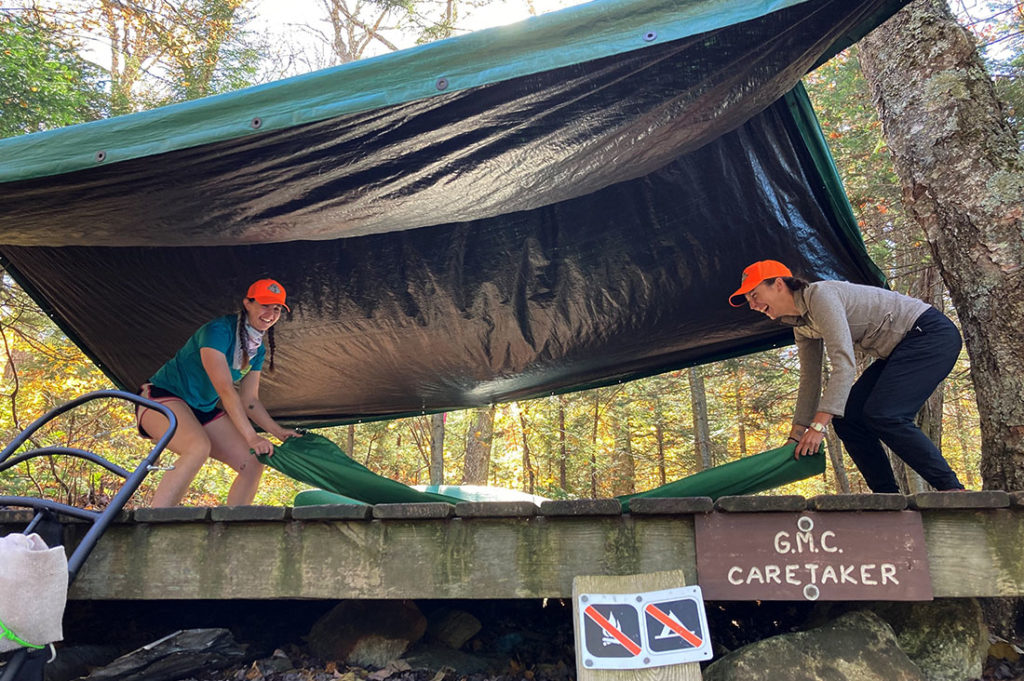
This article previously appeared in the Spring 2021 Long Trail News under the title “Day in the Life of a GMC Caretaker.”
As many more people than usual took up hiking last summer, the Green Mountain Club had to manage their impacts while making them feel welcome. Fortunately our caretakers can tap more than 50 years of experience educating and connecting with hikers while maintaining trails and overnight sites. Dozens of paid GMC caretakers live in the backcountry each season, helping hikers learn how to care for the special places they enjoy. This work, supported by your donations, keeps the Long Trail a world class hiking experience.
Below, Nigel Bates takes us through a typical day in the life of a caretaker.
A Caretaker’s Morning
7:15 a.m.: I wake up on the caretaker bunk in Taft Lodge[1]. Most caretakers tent outside their shelters, but tenting is prohibited at Taft to protect the fragile subalpine ecosystem there. I sleep at Taft during my workweek, Thursday through Monday. On days off I leave the mountain and recharge at GMC headquarters in Waterbury Center.
[1]In 2020 GMC did not station caretakers at Taft and Butler Lodges, to avoid the risk of COVID-19. We plan to resume staffing them this year, with appropriate precautions.
7:30: After a few minutes to gather myself for the day, I climb down and make breakfast. I have to backpack my food to the lodge, so when I shop I choose lightweight but calorie- and nutrient-dense items. Today I opt for a big bowl of oatmeal with dried bananas, and plenty of maple syrup.
As I dig in, I chat with a few thru-hikers about their plans. They’re headed south over Mount Mansfield to Puffer Shelter. I tell them about water availability, stress the ruggedness of the trail, and suggest Taylor Lodge as a fallback if they find themselves behind schedule.
I learned the basics of trail maintenance, privy management and informal hiker education in a two-week preseason training, but like other caretakers, I learned the details of my range on my own.
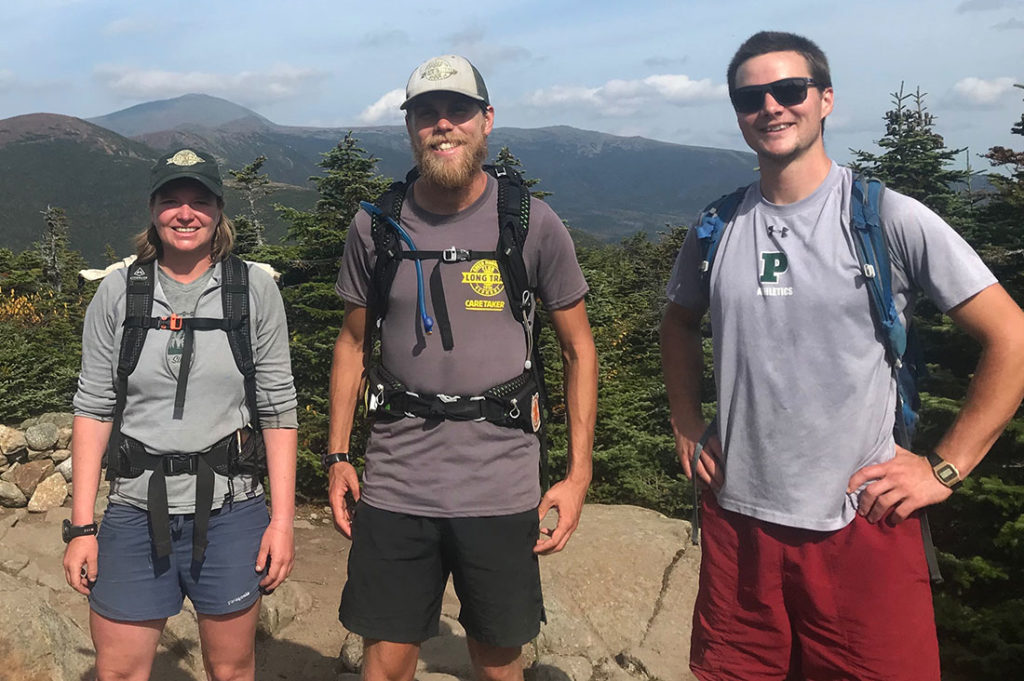
8:15: Once the hikers are off, I gather what I need for a morning on Mansfield’s summit. Some of the supplies are obvious: food, water, a Long Trail map, a first aid kit, and lots of extra layers. Others might surprise you! I never expected to carry a ball of cotton twine (to delineate the trail above treeline), a tally counter (to record the number of visitors to the summit), or an extra dog leash (in case someone arrives at the summit without one), yet all of these are essential components of my summit pack.
8:30: I start up the Long Trail toward the summit. My commute, while only 0.6 miles, is some of the most difficult terrain of the trail. Fortunately I’m now intimately familiar with it!
I arrive to find this morning’s thru-hiker friends basking in the sun and taking in the marvelous view from Vermont’s highest point. They’re in luck — more than half the time, the summit is enshrouded in clouds. I point out some of the main features: Mount Washington and Franconia Ridge to the east, Lake Champlain and the Adirondacks to the west, and the spine of the Green Mountains stretching south to Killington.
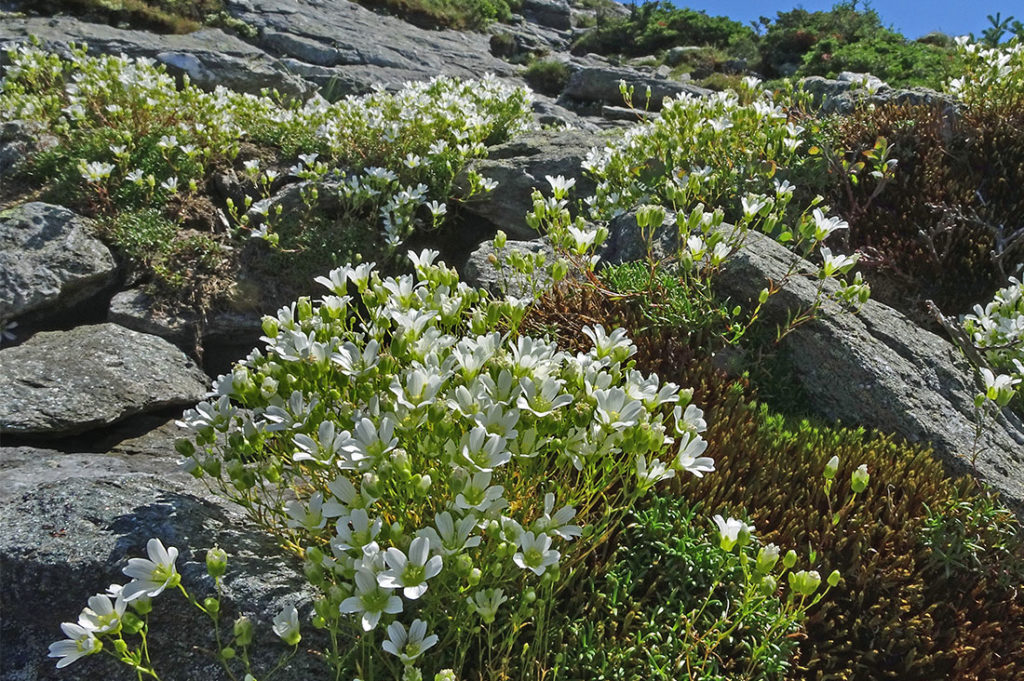
Then I draw their attention downward to the alpine vegetation. These remarkable plants — diapensia, mountain sandwort, Bigelow’s sedge and others — survive on only a few of Vermont’s highest peaks, where harsh weather precludes trees. I remind them to step only on rocks above treeline to avoid trampling this fragile vegetation, a refrain I repeat countless times per day. Promising to do so, they continue their journey.
9:15: A family of day hikers arrives. It’s a beautiful Saturday, so they are bound to be the first of many. I click my counter[2] four times as I say hello, and ask which trail they took. They hiked the Laura Cowles Trail, one of the more strenuous routes, and would like an easier way down. I recommend the Sunset Ridge Trail for stunning views as well as gentler terrain. I snap a family photo and remind them of the fragility of the alpine vegetation. They, too, promise to stay on rocks.
[2]Caretakers count hikers so the club can chart trends from year to year, and devise trail management strategies accordingly.
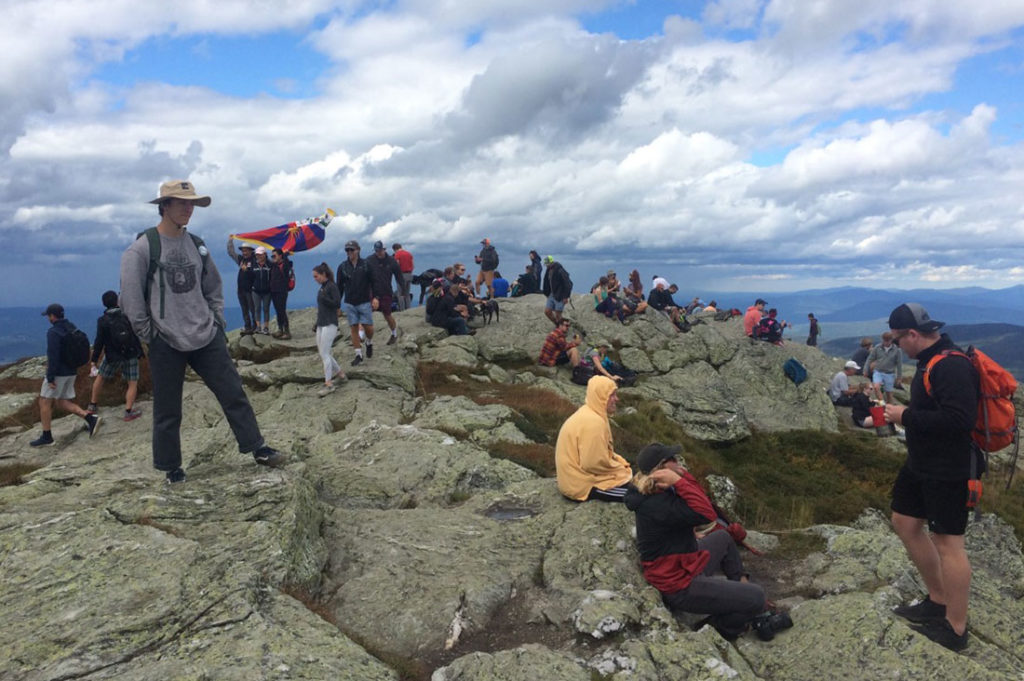
10:30: The summit is getting busy, so it’s time for a trash sweep. Caretakers lead by example, whether on duty or off, so we try to clean up while hikers are watching. As I crisscross the summit with my trash bag (staying on the rocks, of course), I talk with visitors about how we can all help keep the mountain clean. There are always many new hikers, and we strive to introduce them to the principles of trail stewardship in a welcoming and inclusive way. We hope to inspire all visitors, new or experienced, to pack out their trash, and maybe even some left by others!
11:00: A man arrives and begins to set up a drone. I walk over, say a friendly hello, and ask him to refrain from flying the drone on the summit.
“Why not?” he asks, a bit irritated. I explain that drones have a negative impact, not only on other hikers but also on birds. On cue, a peregrine falcon appears overhead and dives into Smuggler’s Notch. We’re both awestruck. As he puts the drone away, I thank him for respecting the wildlife that call Mansfield home. This was an example of soft stewardship: taking an opportunity to make hikers aware of the impacts of their actions and empower them to make good decisions.
A Caretaker’s Afternoon
12:30 p.m.: My summit shift is almost finished, and another caretaker arrives for the afternoon. Since it’s so busy we work together for a while to make sure everyone stays on the rocks while they eat lunch. When the rush subsides, I leave for some trail maintenance lower down the mountain.
1:30: With more than 10 miles of trails in my range, there are always plenty of tasks. Today I decide to clip the corridor on the Hellbrook Trail. Corridor maintenance is a delicate balance: too narrow, and hikers are hit in the face with annoying branches. Too wide, and hikers tend to trample vegetation on the edges of the trail. I clip conservatively here to preserve delicate mosses and bunchberries along the path.
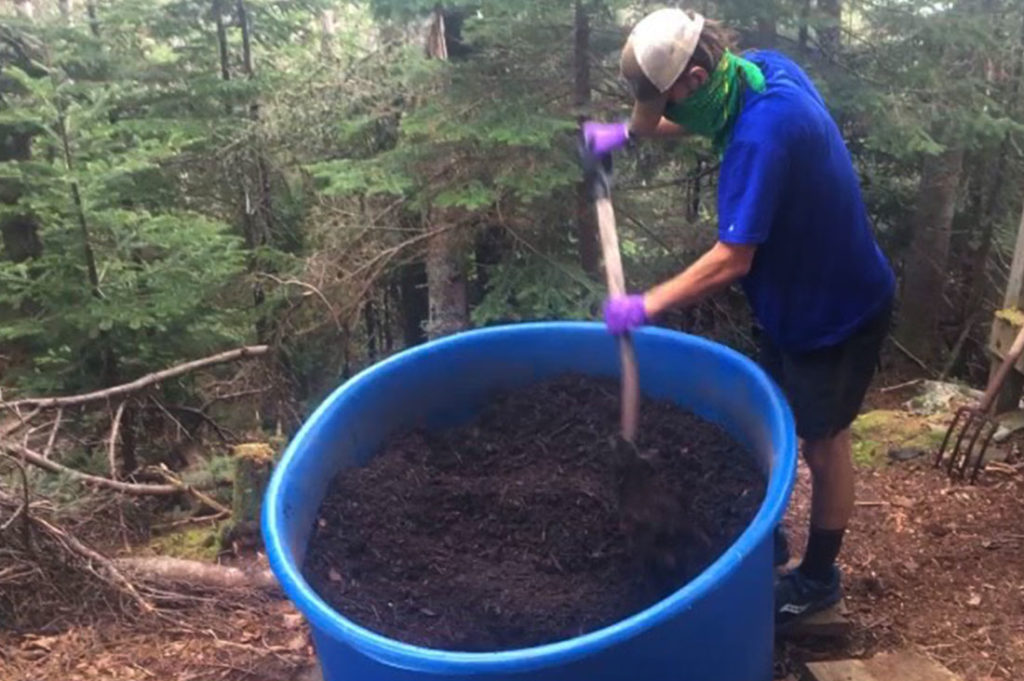
3:30: I rush back to stir the composting run at the privy at Taft. Once a week I spend an hour digging into the pile with a spading fork to break up clumps and redistribute the mixture of waste and bark mulch for another cycle of heating. I explain to a curious group of teenagers that because Taft is such a popular site, it generates a lot of human waste, so we use high-temperature composting to speed the process. We all agree that the process is kind of gross, but also kind of cool.
A Caretaker’s Evening
5:00: After dousing myself in hand sanitizer, I hike out to the Adam’s Apple for a few minutes of solitude before overnight hikers start arriving. Caretaking is a full time job, and while I love interacting with people, it’s important to find time to recharge and remember why I’m out here in the first place. The dramatic views of Lake of the Clouds and Smuggler’s Notch never fail to blow me away.
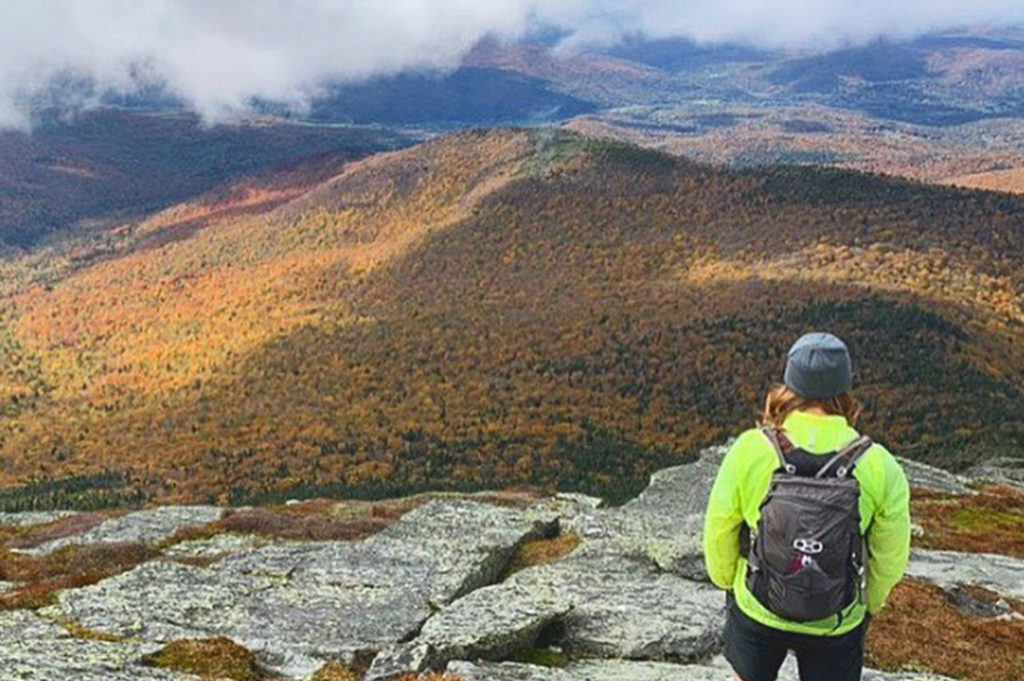
6:00: As it enters its second century, Taft Lodge welcomes a new generation of hikers. This evening while backpackers stream in I orient them to the privy, water source and washpit, gently reminding them of Leave No Trace principles as needed. As stewards of the backcountry, caretakers and hikers new and old should pass along our principles with kindness and respect.
Soon enough the sun goes down, chatter subsides, and hikers retire to sleeping bags. I climb to my bunk and join them in slumber. I’m tired, but it’s a good fatigue, the kind you feel after a long day making a difference. Tomorrow I’ll wake and do it all again. But every day on Mansfield is a little different, and I look forward to seeing what tomorrow will bring.
From May through October Green Mountain Club backcountry caretakers from Stratton Mountain to Sterling Pond spend their days protecting ponds, summits and trails while helping the hiking public get more from their time in the Green Mountains. This rewarding and vital program is possible only through your support through memberships and donations. You enable each caretaker to protect the backcountry, and to welcome and inform the hiking public.
Nigel Bates started with the GMC as Mansfield Lead Caretaker in 2019 and is now entering his second season supervising the caretaker program.



















Excellent presentation of materials.